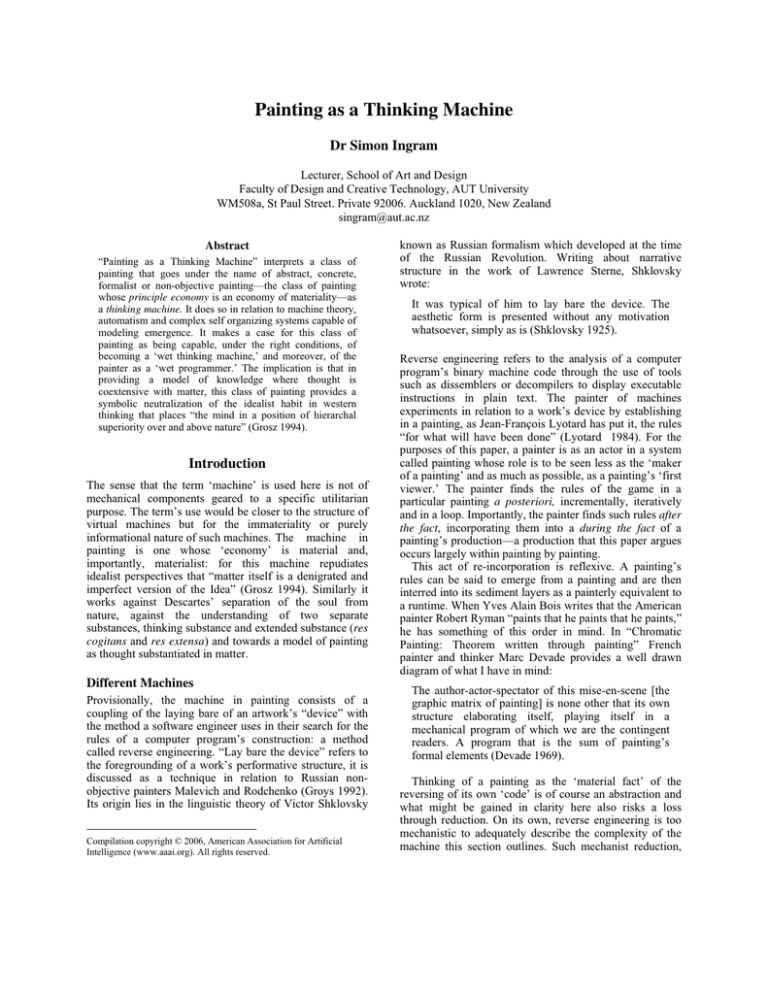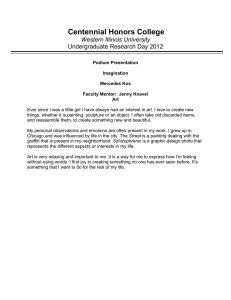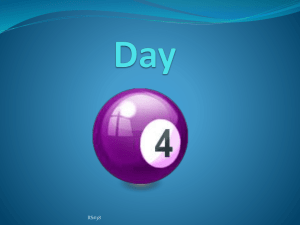
Painting as a Thinking Machine
Dr Simon Ingram
Lecturer, School of Art and Design
Faculty of Design and Creative Technology, AUT University
WM508a, St Paul Street. Private 92006. Auckland 1020, New Zealand
singram@aut.ac.nz
Abstract
“Painting as a Thinking Machine” interprets a class of
painting that goes under the name of abstract, concrete,
formalist or non-objective painting—the class of painting
whose principle economy is an economy of materiality—as
a thinking machine. It does so in relation to machine theory,
automatism and complex self organizing systems capable of
modeling emergence. It makes a case for this class of
painting as being capable, under the right conditions, of
becoming a ‘wet thinking machine,’ and moreover, of the
painter as a ‘wet programmer.’ The implication is that in
providing a model of knowledge where thought is
coextensive with matter, this class of painting provides a
symbolic neutralization of the idealist habit in western
thinking that places “the mind in a position of hierarchal
superiority over and above nature” (Grosz 1994).
Introduction
The sense that the term ‘machine’ is used here is not of
mechanical components geared to a specific utilitarian
purpose. The term’s use would be closer to the structure of
virtual machines but for the immateriality or purely
informational nature of such machines. The machine in
painting is one whose ‘economy’ is material and,
importantly, materialist: for this machine repudiates
idealist perspectives that “matter itself is a denigrated and
imperfect version of the Idea” (Grosz 1994). Similarly it
works against Descartes’ separation of the soul from
nature, against the understanding of two separate
substances, thinking substance and extended substance (res
cogitans and res extensa) and towards a model of painting
as thought substantiated in matter.
Different Machines1
Provisionally, the machine in painting consists of a
coupling of the laying bare of an artwork’s “device” with
the method a software engineer uses in their search for the
rules of a computer program’s construction: a method
called reverse engineering. “Lay bare the device” refers to
the foregrounding of a work’s performative structure, it is
discussed as a technique in relation to Russian nonobjective painters Malevich and Rodchenko (Groys 1992).
Its origin lies in the linguistic theory of Victor Shklovsky
Compilation copyright © 2006, American Association for Artificial
Intelligence (www.aaai.org). All rights reserved.
known as Russian formalism which developed at the time
of the Russian Revolution. Writing about narrative
structure in the work of Lawrence Sterne, Shklovsky
wrote:
It was typical of him to lay bare the device. The
aesthetic form is presented without any motivation
whatsoever, simply as is (Shklovsky 1925).
Reverse engineering refers to the analysis of a computer
program’s binary machine code through the use of tools
such as dissemblers or decompilers to display executable
instructions in plain text. The painter of machines
experiments in relation to a work’s device by establishing
in a painting, as Jean-François Lyotard has put it, the rules
“for what will have been done” (Lyotard 1984). For the
purposes of this paper, a painter is as an actor in a system
called painting whose role is to be seen less as the ‘maker
of a painting’ and as much as possible, as a painting’s ‘first
viewer.’ The painter finds the rules of the game in a
particular painting a posteriori, incrementally, iteratively
and in a loop. Importantly, the painter finds such rules after
the fact, incorporating them into a during the fact of a
painting’s production—a production that this paper argues
occurs largely within painting by painting.
This act of re-incorporation is reflexive. A painting’s
rules can be said to emerge from a painting and are then
interred into its sediment layers as a painterly equivalent to
a runtime. When Yves Alain Bois writes that the American
painter Robert Ryman “paints that he paints that he paints,”
he has something of this order in mind. In “Chromatic
Painting: Theorem written through painting” French
painter and thinker Marc Devade provides a well drawn
diagram of what I have in mind:
The author-actor-spectator of this mise-en-scene [the
graphic matrix of painting] is none other that its own
structure elaborating itself, playing itself in a
mechanical program of which we are the contingent
readers. A program that is the sum of painting’s
formal elements (Devade 1969).
Thinking of a painting as the ‘material fact’ of the
reversing of its own ‘code’ is of course an abstraction and
what might be gained in clarity here also risks a loss
through reduction. On its own, reverse engineering is too
mechanistic to adequately describe the complexity of the
machine this section outlines. Such mechanist reduction,
seen in Descartes for instance, in comments such as “I
have described this earth and indeed the whole invisible
universe as if it were a machine” (Descartes in Garber
2001) needs exposure to materialist and organicist
perspectives.
A productive example is the materialism of C18 Julien
de Offray La Mettrie, who offered a changed perspective
of Decartes’ mechanism. La Mettrie saw organic matter as
having “active” and “formal” properties that included
feeling and thought, Justin Leiber writes: “Materialism is
often presented soberly [as an] austerely mechanical world,
but La Mettrie eroticizes nature as a world of colour and
joy, a blooming and bidding kaleidoscopic biosphere”
(Leiber 1994). La Mettrie saw attempts to uncover the
“nature of man” by philosophy had up until then made
their cases “a priori…by…taking flight…with the wings
of the mind;” because of this, they had done so “in vain;”
much better, claims La Mettrie, to work “a posteriori [to
unravel] the soul as one pulls the guts out of a body” (La
Mettrie 1748).
The wet messiness of such an unravelling would help
reverse engineering in painting out a specific mechanist
dryness that reverse engineering might engender. Yet in
itself this is not entirely sufficient, because as Samuel
Taylor Coleridge saw, there are inadequacies in the
“stepwise analytical method” (Coleridge in Ritterbush
1968). Machines, he argued, might best be understood by
taking them apart but the dissection of a living organism
“[yields]
members
whose
meaning
[is]
lost
when…removed from the intact body.”1 Put differently, in
the case of complex machines, when a ‘component’ of a
complex living system is decontextualized a correlate loss
of meaning can accrue.
To understand organization in living entities Coleridge
proposed that “the mind must project something of itself
into nature” (Coleridge in Ritterbush 1968). Yet, this is not
satisfactory either, the machine in painting has less in
common with a mind projected into painting than one
interred there after and through the fact of its production.
This is thinking that finds its articulation in an address to
the painter-viewer ensemble as if the painting had become
an object imbued with subjectivity and an ability to think.
A productive way to discuss this condition is as
autopoiesis developed as a method in painting. The
neologism autopoiesis refers to auto-production or selfmaking, poiesis derives from the Greek meaning both
‘creation’ and ‘to make.’ The word appeared in the
nineteen seventies in the context of work by evolutionary
biologists Humberto Maturana and Francisco Varela.
Simplifying to the extreme, from Maturana and Varela’s
biological perspective, all living systems are machines
engaged in the business of self-making, and as such they
are autopoietic. All other machines, generally those that are
not living, produce outcomes quite different from
themselves; a tire factory doesn’t produce tire factories, it
produces tires, etc. Autopoiesis provides a diagram of
‘thinking substance’ at the same level as ‘extended
substance,’ the autopoietical scenario has thought not
separate from matter but emerging from its complex
relations. Techniques of autopoiesis are echoed in
comments made by Polish artists Strzemi ski and Kobro:
[Painting is something:] built in accordance with its
own principles, [that] stands up beside other worldly
organisms as a parallel entity, as a real being, for
everything has its own laws of construction of its
organism (Strzemi ski and Kobro in Bois 1990).
The machine in painting is nearly the sum of these
approaches. More readily, it can be discussed in terms of a
convergence of mechanism with the implicit vitalism of
organic form outlined here by Coleridge:
[Organic form] is innate [and] shapes itself from
within…the fullness of its development is one and the
same with the perfection of its outward form. Such is
the life, such the form (Coleridge in Ritterbush 1968).
An example of convergence is found in the blurring of
mechanist and vitalist distinctions that cellular automata
can be said to enact. In the outcomes of these twodimensional finite state diagramming machines which
model “bottom up” organization and emergence through
mechanist, and importantly, reflexive means and which
fulfill the condition of autopoiesis, but which are not
actually living. Katherine Hayles gives a useful description
of the modus operandi of a generic cellular automata:
Each cellular automata…functions as a simple finite
state machine, with its state determined solely by its
initial condition (on or off), by rules telling it how to
operate, and by the state of its neighbors at each
moment [e.g.] ‘on if two neighbors are on, otherwise
off.’ Each cell checks the state of its neighbors and
updates its state in accordance with its rules at the
same time that the neighboring cells also update their
states (Hayles 1999).
The Machine and the Subject Position of the
Painter
This model of a computational finite state reflexive
machine, relates to a condition in painting that is either
strictly non-computational or else one that is computational
in highly complex and yet to be established ways. The last
option suggests that painting can tell us something about
machine thinking and this is the one this paper favors.
Strategies of automatization and specific understandings
of painting as mechanical program—ones not tied
expressly to a computational metaphor but which share in
their sets of procedural logics—have been put to use to decenter and attenuate the subject position of the painter as
content provider. Such strategy is discussed in “Toward a
Theory/Practice of Painting in France” (Rodgers 1979), in
Rules of the Game: The Painter and his Constraints
(Huitorel 1999) and in “Chromatic Painting: Theorem
written through painting” (Devade 1969). Such decentering
has a political dimension because of the way it calls into
question the assumptions and ideology that underpin the
primacy of the humanist subject, a question of manifest
importance to painting.
Rodger’s essay formulates a structuralist version of
materialist philosophy in a pitched battle against idealism
in general, and in particular, in relation to the question of
the identity of the subject in painting. This idealism is of
the kind that separates thought from sensuous human
activity, theory from practice, thought from matter.
Rodger’s point is that thought in the work of these painters
occurs at the level of matter, and is matter, thought is
substantiated in, and extended through, painting’s body by
use of automatism and in conjunction with the synthesis of
theory and practice as praxis.
Providing an interesting distinction between “American
formalism” and the interests of the group of French
painters he refers to, Rodgers claims that the French sought
“to free the American painting it admired from a formalist
interpretation” (Rodgers 1979). Formalist interpretation
relates to a foundational attitude in Western thinking,
namely the mind body opposition, and here more
relevantly, the distinction between form and matter: a
distinction where form is structured as a reasonable version
its unruly pair matter. This interpretation refers also to the
turn away from earlier surrealist and abstract expressionist
interests in content production occurring outside the reach
of consciousness through automatist methods. Methods
that acknowledge the subject position of the painter while
de-centering and attenuating that position, leading one to
consider how an artwork can manifest the property of
thought.
Re-evaluation of Pollock’s work outside the frame of
reference of American formalism is echoed elsewhere: the
French painter Simon Hantai saw Pollock’s drip technique
as a “logical, lively, and pertinent” development of the
automatism of Surrealist painting. Andre Masson regarded
Pollock’s technique as “an equivalent to automatic
writing.” Michel Parmentier interpreted Pollock’s work as
an “essential link in surrealism [though this was]
something André Breton could not accept” (Huitorel
1999). Seen from the perspective Huitorel outlines in his
Rules of the Game: The Painter And His Constraints,
Pollock’s drip technique is a painterly interpretation of the
surrealist paper game the le cadavre exquis (the exquisite
corpse) which defers authorial productivity into automatic
pictorial relationships that emerge out of drawing.
Elsewhere, Alain Cueff writes that Pollock was
significant to a group of artists whose “keyword” was
deconstruction and whose explorations “sought to maintain
close and privileged links with the philosophical thought of
[that] moment” (Cueff 2000). Like deconstruction, the
French painting provides recognition of its existence
within an ideological structure of production and reception.
It understands that there is no outside of this structure and
it places emphasis on practice and theory in order to
neutralize and compensate the effects of the dominant
ideological structure. The class of painting I have in mind
provides a symbolic neutralization of the idealist habit in
western thinking that places “the mind in a position of
hierarchal superiority over and above nature” (Grosz 1994)
by providing a model of knowledge where thought is
coextensive with matter.
Conclusion
The metaphysicians who suggest that matter might
manifest the faculty of thinking have not dishonored
reason (La Mettrie 1748).
A statement made by Lenin is central to “Painting as a
Thinking Machine.” Lenin says, quite simply, “matter
thinks.” In this context it is not so much the human subject
that thinks as “his matter of subject” and the “whole
function of idealism” is to convince the already established
human subject that they are above so-called, “inorganized
matter” (Lenin quoted in Rodgers 1979). In quite a
different context, that of complexity, Stephen Wolfram’s
Theory of Computational Equivalence’ has it that all
systems “whose behaviour is not obviously simple” are at
the same level of computational sophistication. So in the
end, writes Wolfram, there is “no difference between the
level of computational sophistication that is achieved by
humans and by all sorts of other systems in nature and
elsewhere” (Wolfram 2002). In these contexts, and, in the
class of painting discussed here, it should now be possible
to see how thinking substance and extended substance
coalesce.
To take seriously the implication that “matter thinks”
would be to accept the class of painting that goes under the
name of abstract, formalist or non-objective painting—the
class of painting whose principle economy is an economy
of materiality—as a thinking machine. Here, one could fold
over Marcel Duchamp’s quip “bê te comme un peintre”(as
stupid as a painter) to show how it reveals an idealist
prejudice that thought is something abstract, ungrounded in
matter, and consequently that matter is “inorganized.” In
light of this, Duchamp’s recognition of the painter’s
supposed stupidity provides for recognition of his failure to
see that a given painting’s thinking might be interred in
painting’s matter as opposed to in the painter. Put
differently, if Duchamp considers the painter stupid,
committed to what he refers to as “olfactory masturbation”
and “the smell of turpentine,” he also fails to see that while
techniques of automatization might work to make the
painter stupid, in an action commensurate with this, they
make a painting intelligent.
Specifically then, how does the question of subjectivity
and thinking in painting shift from a question of that of a
painter to one of a painting? Automatist techniques such as
those developed by Max Ernst and Joan Miro of frottage
(rubbing) and grattage (scraping), Pollock’s drip
technique, Simon Hantai’s method of painting folded
canvas, Robert Ryman’s reflexive and organic/mechanic
brush stroke can all be said to expand the space between
painter and painting through mediation. In this new zone a
different kind of thinking occurs:
…the conscious subject undergoes an eclipse during
such a production, a new subjectivity is objectified
(Durozi and Lecherbonnier in Huitorel 1999).
It is this new subjectivity objectified as material into
painting’s sediment layers that lets painting think. The
class of painting in mind here should be seen as an
engineering of sorts, the painter as a ‘wet programer’
working with painting givens, with colored mud in binder,
running a software oriented variation of earlier automatist
method—that is, with new methods derived from cellular
automata—on the hardware of the painting support using
other material bodies such as brushes and tape, all with
their own procedural codes, their own systemics, and all
with a job to do, to put thinking into the ground of
painting.
Acknowledgements
I would like to thank Jan Bryant, Wystan Curnow and
especially Allan Smith, who, in different ways, have urged
me to deepen and test ideas both in this paper and in my
paintings and painting machines. They have been ‘friendly
readers,’ fair minded critics and warm conversationalists.
Notes
For a discussion on how the work of C18 Mechanicians and
the materialism of La Mettrie blurred distinctions between
machines and living entities, and how the property of wetness
was central to this, see Jessica Riskin, “Eighteenth Century
Wetware.”
References
Bois, Y., A. 1990. Strzemi ski and Kobro: In Search of
Motivation. In Painting as Model. Cambridge, Mass: MIT.
123-155.
Cueff, A. 2000. French Art After America, A Partial View Of
The French Exception.” French Culture.org. April 2004.
<http://www.frenchculture.org/art/texts/cueff/>
Deleuze, G. and Guattari, F. 1977. Balance Sheet – Program
For Desiring Machines. In Semiotext(e) Vol. II, no. 3. (1977):
1997. 117-135.
De Duve, T. 2001. Look, 100 Years of Contemporary Art.
Ghent-Amsterdam: Ludion.
De Landa, M. 1997. The Machinic phylum. In
V2_Organisation. May 2006.
<http://framework.v2.nl/archive/archive/node/text/.xslt/nodenr
-70071>
Devade, M. 1969. Chromatic Painting. Theorem written
through painting. In The Tel Quel Reader. London & New
York: Routledge, 1998. 181-197.
Garber, D. 2001. Descartes and the Scientific Revolution:
Some Kuhnian Reflections. In Perspectives on Science Vol. 9,
no 4. 405-422.
Grosz, E. 1994. Refiguring Bodies. In Volatile Bodies:
Toward a Corporeal Feminism. Indiana: Indiana University
Press. 3-24.
Groys, B. 1992. The Russian Avant-Garde: The Leap of
Progress. The Total Art of Stalinism, The Avant-garde, Aesthetic
Dictatorship and Beyond. Princeton, NJ: Princeton University
Press.
Hayles, K. 1999. How We Became Posthuman: Virtual Bodies
In Cybernetics, Literature, And Informatics. Chicago:
University of Chicago Press.
Huitorel, J., M. 1999. The Role of Simon Hantai. In The Rules
of the Game: The Painter and his Constraints. Frac BasseNormandie. 38-49.
Johnson, J. 1999. Machinic Vision. In Critical Inquiry 26. 2748.
Kuh, K. 1962. The Artist’s Voice: Talks with Seventeen
Artists. New York: Harper and Row.
La Mettrie, J., O. 1748. Man a Machine. In Man A Machine
and Man A Plant. Indianapolis: Cambridge, Hackett
Publishing, 1994.
Leiber, J. 1994. Introduction. In Man A Machine and Man A
Plant. Indianapolis: Cambridge, Hackett Publishing.
Levy, Steven. 2002. The Man Who Cracked the Code to
Everything.” Wired. April 2004.
<http://www.wired.com/wired/archive/10.06/wolfram.html>
Lyotard, J. F. 1984. Answering the question: What is
Postmodernism? In The Postmodern Condition: A Report on
Knowledge. Minneapolis: University of Minnesota Press. 7182.
McEvilley, T. 1991. On the Manner of Addressing Clouds. In
Art and Discontent: Theory at the Millennium. New York:
Documentext. 63-69.
Marvin, W. T. 1918. Mechanism Verses Vitalism As a
Philosophical Issue. In The Philosophical Review. Vol. 27,
No. 6. 616-627.
Merritt, R., K. 2003. Intentions: Logical and Subversive, The
Art of Marcel Duchamp, Concept Visualization, and
Immersive Experience. In Tout Fait, The Marcel Duchamp
Studies Online. April 2004.
<http://www.toutfait.com/issues/volume2/issue_5/articles/mer
ritt/merritt1.html>
Riskin, J. 2003. The Defecating Duck, Or, the Ambiguous
Origins of Artificial Life. Critical Inquiry 29, no. 4. 599–633.
Riskin, J. 2003. Eighteenth Century Wetware. In
Representations 83. 97-125.
Ritterbush, P., C. 1968. Esthetics and Analogies to Life. In
The Art of Organic Forms. Washington: Smithsonian
Publications. 16-17.
Rodgers, P. 1979. Towards a Practice of Painting in France. In
Art Forum Magazine April. 54-61.
Shklovsky, V. 1925. The Novel as Parody: Sterne’s Tristram
Shandy. In Theory of Prose. Elmwood Park, IL: Dalkey
Archive Press, 1991. 147-170.
Thurtle, P. and Mitchell, R. 2004. Data Made Flesh. New
York: Routledge.
Wolfram. S. 2002. A New Kind of Science. Champaign, IL:
Wolfram Media, 2002.







